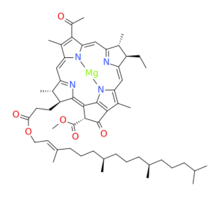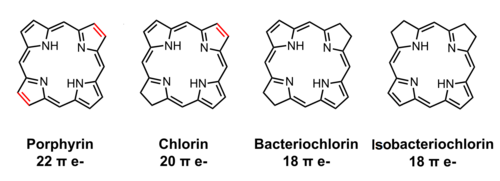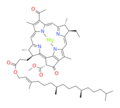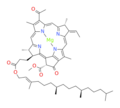Chemistry:Bacteriochlorophyll

| |
| Names | |
|---|---|
| IUPAC name
[methyl (3S,4S,13R,14R,21R)-9-acetyl-14-ethyl-4,8,13,18-tetramethyl-20-oxo-3-(3-oxo-3-([(2E,7R,11R)-3,7,11,15-tetramethylhexadec-2-en-1-yl]oxy)propyl)-13,14-dihydrophorbine-21-carboxylatato(2−)-kappa4N23,N24,N25,N26]magnesium
| |
| Identifiers | |
3D model (JSmol)
|
|
| ChEBI | |
| ChemSpider | |
| KEGG | |
PubChem CID
|
|
| |
| |
| Properties | |
| MgC 55H 74N 4O 6 | |
| Molar mass | 911.524 g·mol−1 |
| Appearance | Light green to blue-green powder |
Except where otherwise noted, data are given for materials in their standard state (at 25 °C [77 °F], 100 kPa). | |
| Infobox references | |
Bacteriochlorophylls (BChl) are photosynthetic pigments that occur in various phototrophic bacteria. They were discovered by C. B. van Niel in 1932.[1] They are related to chlorophylls, which are the primary pigments in plants, algae, and cyanobacteria. Organisms that contain bacteriochlorophyll conduct photosynthesis to sustain their energy requirements, but the process is anoxygenic and does not produce oxygen as a byproduct. They use wavelengths of light not absorbed by plants or cyanobacteria. Replacement of Mg2+ with protons gives bacteriophaeophytin (BPh), the phaeophytin form.
| Pigment | Taxa | in vivo infrared absorption maximum (nm) |
|---|---|---|
| BChl a | Purple bacteria, Heliobacteria, Green Sulfur Bacteria, Chloroflexota, Chloracidobacterium thermophilum[2] | 805, 830–890 |
| BChl b | Purple bacteria | 835–850, 1020–1040 |
| BChl c | Green sulfur bacteria, Chloroflexota, C. thermophilum,[2] C. tepidum | 745–755 |
| BChl d | Green sulfur bacteria | 705–740 |
| BChl e | Green sulfur bacteria | 719–726 |
| BChl f | (Discovered by mutation of BChl e synthesis by analogy to BChl c/d. Not evolutionarily favorable.)[3] | 700–710 |
| BChl g | Heliobacteria | 670, 788 |
- Structures of major bacteriochlorophylls
-
bacteriochlorophyll a
-
bacteriochlorophyll b
-
bacteriochlorophyll c
-
bacteriochlorophyll d
-
bacteriochlorophyll e
-
bacteriochlorophyll f
-
bacteriochlorophyll g
Structure

Bacteriochlorophylls a, b, and g are bacteriochlorins, meaning their molecules have a bacteriochlorin macrocycle ring with two reduced pyrrole rings (B and D). Bacteriochlorophylls c, d, e, and f are chlorins, meaning their molecules have a chlorin macrocycle ring with one reduced pyrrole ring (D).[4]
Bacteriochlorophylls c to f occur in the form of closely related homologs with different alkyl groups attached to pyrrole rings B and C and are illustrated above in their simplest versions, esterified with the sesquiterpene alcohol farnesol.[5] Most of the variation occurs in the 8 and 12 positions and can be attributed to methyltransferase variation.[6] BChl cS is a term for 8-ethyl,12-methyl homolog of BChl c.[7]
Bacteriochlorophyll g has a vinyl group in ring (A), at position 8.[8]
Biosynthesis

There are a large number of known bacteriochlorophylls[4][9] but all have features in common since the biosynthetic pathway involves chlorophyllide a (Chlide a) as an intermediate.[10]
Chlorin-cored BChls (c to f) are produced by a series of enzymatic modifications on the sidechain of Chlide a, much like how Chl b, d, e are made. The bacteriochlorin-cored BChls a, b, g require a unique step to reduce the double bound between C7 and C8, which is performed by Chlorophyllide a reductase (COR).[9]
Isobacteriochlorins, in contrast, are biosynthesised from uroporphyrinogen III in a separate pathway that leads, for example, to siroheme, cofactor F430 and cobalamin. The common intermediate is sirohydrochlorin.[11]
References
- ↑ Niel, C. B. (1932). "On the morphology and physiology of the purple and green sulphur bacteria". Archiv für Mikrobiologie 3: 1–112. doi:10.1007/BF00454965.
- ↑ 2.0 2.1 Bryant, Donald A. et al. (2007-07-27), "Candidatus Chloracidobacterium thermophilum: An Aerobic Phototrophic Acidobacterium", Science 317 (5837): 523–526, doi:10.1126/science.1143236, PMID 17656724, Bibcode: 2007Sci...317..523B
- ↑ Vogl, Kajetan et al. (2012-08-10). "Bacteriochlorophyll f: properties of chlorosomes containing the "forbidden chlorophyll"". Front. Microbiol. 3: article 298, pages 1–12. doi:10.3389/fmicb.2012.00298. PMID 22908012.
- ↑ 4.0 4.1 Senge, Mathias O.; Smith, Kevin M. (2004). "Biosynthesis and Structures of the Bacteriochlorophylls". Anoxygenic Photosynthetic Bacteria. Advances in Photosynthesis and Respiration. 2. pp. 137–151. doi:10.1007/0-306-47954-0_8. ISBN 0-7923-3681-X.
- ↑ Harada, Jiro; Shibata, Yutaka; Teramura, Misato; Mizoguchi, Tadashi; Kinoshita, Yusuke; Yamamoto, Ken; Tamiaki, Hitoshi (2018). "In Vivo Energy Transfer from Bacteriochlorophyll c , d , e , or f to Bacteriochlorophyll a in Wild-Type and Mutant Cells of the Green Sulfur Bacterium Chlorobaculum limnaeum". ChemPhotoChem 2 (3): 190–195. doi:10.1002/cptc.201700164.
- ↑ Gomez Maqueo Chew, A; Frigaard, NU; Bryant, DA (September 2007). "Bacteriochlorophyllide c C-8(2) and C-12(1) methyltransferases are essential for adaptation to low light in Chlorobaculum tepidum.". Journal of Bacteriology 189 (17): 6176–84. doi:10.1128/JB.00519-07. PMID 17586634.
- ↑ Gloe, A; Risch, N (1 August 1978). "Bacteriochlorophyll cs, a new bacteriochlorophyll from Chloroflexus aurantiacus.". Archives of Microbiology 118 (2): 153–6. doi:10.1007/BF00415723. PMID 697505.
- ↑ Tsukatani, Yusuke; Yamamoto, Haruki; Mizoguchi, Tadashi; Fujita, Yuichi; Tamiaki, Hitoshi (2013). "Completion of biosynthetic pathways for bacteriochlorophyll g in Heliobacterium modesticaldum: The C8-ethylidene group formation". Biochimica et Biophysica Acta (BBA) - Bioenergetics 1827 (10): 1200–1204. doi:10.1016/j.bbabio.2013.06.007. PMID 23820336.
- ↑ 9.0 9.1 Chew, Aline Gomez Maqueo; Bryant, Donald A. (2007). "Chlorophyll Biosynthesis in Bacteria: The Origins of Structural and Functional Diversity". Annual Review of Microbiology 61: 113–129. doi:10.1146/annurev.micro.61.080706.093242. PMID 17506685.
- ↑ Willows, Robert D. (2003). "Biosynthesis of chlorophylls from protoporphyrin IX". Natural Product Reports 20 (6): 327–341. doi:10.1039/B110549N. PMID 12828371.
- ↑ Battersby, Alan R. (2000). "Tetrapyrroles: The pigments of life: A Millennium review". Natural Product Reports 17 (6): 507–526. doi:10.1039/B002635M. PMID 11152419.
de:Chlorophylle#Chemische Struktur bei anoxygenen Phototrophen: Bakteriochlorophylle (Bchl)
 |







